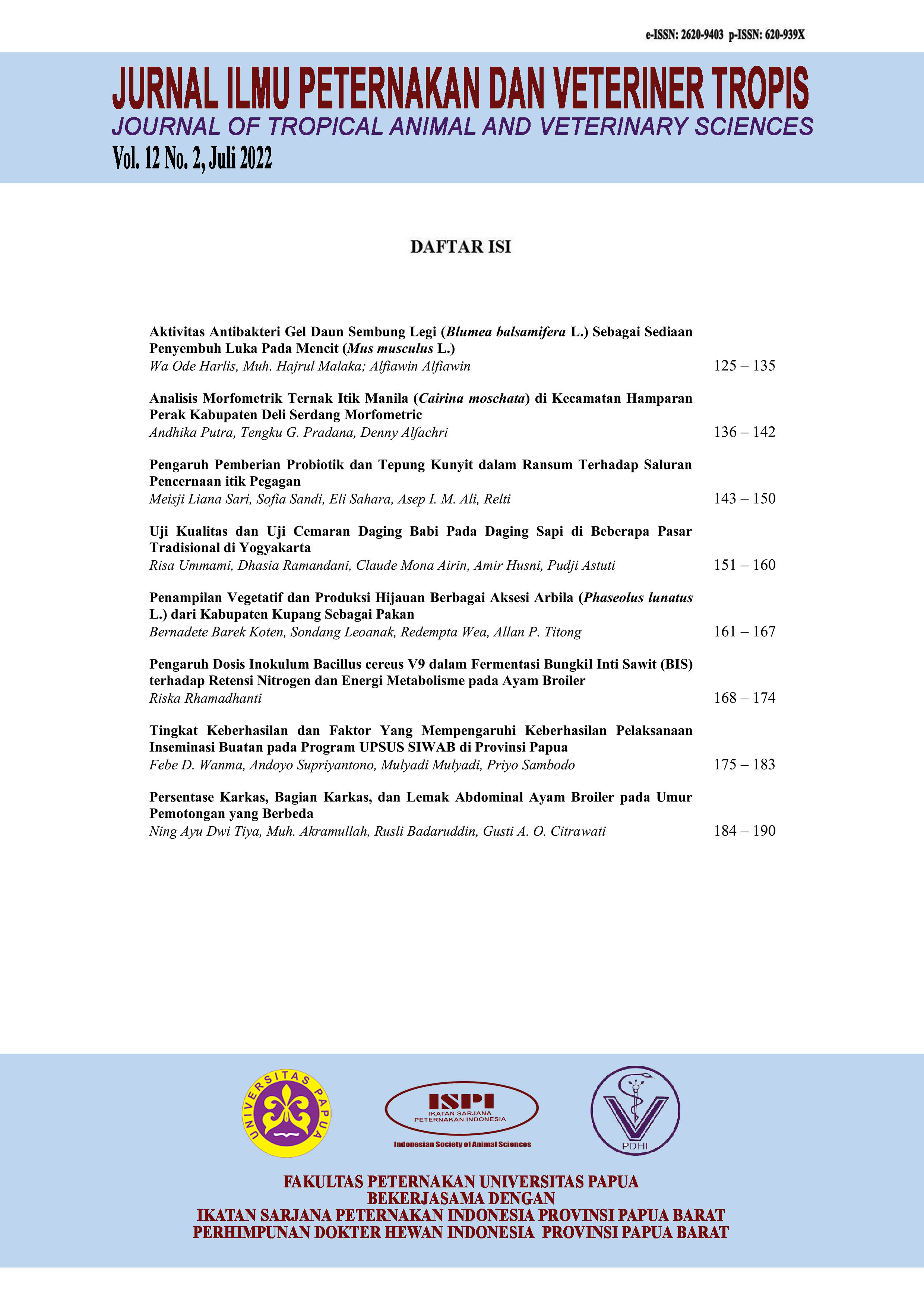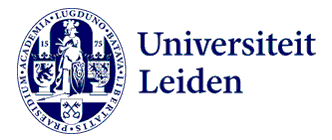Penampilan Vegetatif dan Produksi Hijauan Berbagai Aksesi Arbila (Phaseolus lunatus L.) dari Kabupaten Kupang Sebagai Pakan
Vegetative Performance and Forage Production of Various Accesses of Arbila (Phaseolus lunatus L.) from Kupang District as Feed
DOI:
https://doi.org/10.46549/jipvet.v12i2.285Keywords:
Legum Arbila (Phaseolus lunatus L.), Bintil akar, Jumlah tunas, Pakan, Vegetatif.Abstract
Abstract
The study aimed to evaluate the vegetative appearance and performance of arbila (Phaseolus lunatus L.) from Kupang Regency which was used as feed. Research was carried out in Politani land for 6 months, with 43 accessions and 3 replications. The variables observed were root length, root weight, number of root nodules, percentage of effective root nodules, root nodule diameter, number of green leaves per plant, individual leaf area, leaf weight, stem length, stem diameter, stem weight, number of shoots, and weight of top plant. The results showed that overall, root length was 19–52 cm, root weight was 15–110 g/plant, number of nodules ranged from 0–257 pieces, percentage of effective nodules ranged from 0–100%, and nodule diameter was 0.11–0.98 cm. The number of green leaves ranged from 29.5–128.5 fruit/plant, leaf area 8.11–38.17 cm2, leaf weight ranged from 16–199.5 g/tree. Stem length ranged from 144-358 cm/plant, stem diameter ranged from 0.15 to 0.75 cm, stem weight ranged from 26 to 130.5 g/plant, shoots ranged from 3.5 to 28 shoots/plant, and plant weight of the top plant are 29-316 g/plant. It was concluded that there were differences in the vegetative parts of arbila as seen from the performance of roots, stems, and leaves of various accessions. Accession K10 showed the best root performance, and accession K8, K19 and K45 showed the best shoots, stem, and leaf performance, and forage production as feed.
Keywords: Arbila legume; Feed; Number of shoots; Root nodule; Vegetative
Abstrak
Penelitian yang bertujuan untuk mengevaluasi penampilan bagian vegetatif dan performa arbila (Phaseolus lunatus L.) yang berasal dari Kabupaten Kupang yang terbaik sebagai pakan, telah dilaksanakan di lahan Politani selama 6 bulan, dengan 43 jumlah aksesi dan 3 ulangan. Variabel yang diamati adalah panjang akar, bobot akar, jumlah bintil akar, persentasi bintil akar efektif, diameter bintil akar, jumlah daun hijau per tanaman, luas individu daun, bobot daun, panjang batang, diameter batang, bobot batang, jumlah tunas, dan bobot tanaman bagian atas. Data dianalisis dan dideskripsikan. Hasil penelitian menunjukkan bahwa secara keseluruhan, panjang akar 19–52 cm, bobot akar 15–110 g/tanaman, jumlah bintil berkisar 0–257 buah, persentasi bintil efektif berkisar antara 0–100 %, dan diameter bintil 0,11–0,98 cm. Jumlah daun hijau berkisar 29,5–128,5 buah/tanaman, luas daun 8,11–38,17 cm2, bobot daun berkisar 16–199,5 g/pohon. Panjang batang berkisar 144-358 cm/tanaman, diameter batang berkisar 0,15–0,75 cm, bobot batang berkisar antara 26–130,5 g/tanaman, jumlah tunas berkisar 3,5–28 tunas/tanaman, dan bobot tanaman bagian atas adalah 29-316 g/tanaman. Disimpulkan bahwa terdapat perbedaan bagian vegetatif arbila yang terlihat dari performa akar, batang, dan daun dari berbagai aksesi arbila. Aksesi K10 memperlihatkan performa akar terbaik dan aksesi K8, K19 dan K45 memperlihatkan performa tunas, batang dan daun dan produksi hijauan terbaik sebagai pakan ternak.
Kata Kunci: Bintil akar; Jumlah tunas, Legum Arbila; Pakan; Vegetatif.
Downloads
References
AINS dan Torey P. 2013. Karakter morfologi akar sebagai indikator kekurangan air pada tanaman. Jurnal Bioslogos. 3(1): 31-39.
BPS NTT (Badan Pusat Statistik Nusa Tenggara Timur). 2020. Nusa Tenggara timur dalam Angka. BPS NTT, Kupang.
Koten BB, Soetrisno RD, Ngadiyono N, dan Soewignyo B. 2012. Forage productivity of Arbila (Phaseolus lunatus) at various levels of rhizobium inoculants and harvesting times. J. Indonesian Trop. Anim. Agric. 37(4): 286-293.
Koten BB, Wea R, Randu MD, Dato TD, dan Titong AP. 2020. Arbila (Phaseolus lunatus L) diversity as food and feed in nekamese sub-district based on seed morphology of bean. Prosiding The 1st International Conference on Veterinary and Animal Science (ICon-VAS) 2020 Faculty of Veterinary Medicine Nusa Cendana University. Pp. 33-41.
Koten BB, dan Wea R. 2020a. Keanekaragaman Arbila (Phaseolus lunatus L) di Kecamatan Fatuleu berdasarkan morfologi biji. Prosiding Seminar Nasional Politani Ke 3. Pp. 321-328.
Koten BB, dan Wea R. 2020. Keanekaragaman Arbila (Phaseolus lunatus L) di Kabupaten Kupang berdasarkan morfologi biji. Laporan Penelitian Politeknik Pertanian Negeri Kupang.
Nurhidayati N dan Ramlah R. 2020. Pengaruh pupuk kandang ayam dan SP-36 terhadap performa sistem perakaran dan hasil tanaman Kacang Tanah (Arachis hypogeae Linn). Jurnal Pertanian Terpadu. 8(1): 76-84.
Sari R dan Prayudyaningsih R. 2015. Rhizobium: pemanfaatannya sebagai bakteri penambat nitrogen. Info Teknis EBONI. 12(1): 51-64.
Syahputra BSA. 2021. Hubungan luas daun, diameter batang dan tinggi tanaman padi karena perbedaan waktu aplikasi paclobutrazol (PBZ). Agrium. (24)1: 28–33.
Downloads
Published
How to Cite
Issue
Section
License
Copyright (c) 2022 Bernadete Barek Koten, Sondang Leoanak, Redempta Wea, Allan P. Titong

This work is licensed under a Creative Commons Attribution-NonCommercial-ShareAlike 4.0 International License.
License and Copyright Agreement
In submitting the manuscript to the journal, the authors certify that:
- They are authorized by their co-authors to enter into these arrangements.
- The work described has not been formally published before, except in the form of an abstract or as part of a published lecture, review, thesis, or overlay journal. Please also carefully read Jurnal Ilmu Peternakan dan Veteriner Tropis (Journal of Tropical Animal and Veterinary Science) Posting Your Article Policy at https://journal.fapetunipa.ac.id/index.php/JIPVET/publicationethics
- That it is not under consideration for publication elsewhere,
- That its publication has been approved by all the author(s) and by the responsible authorities “tacitly or explicitly“ of the institutes where the work has been carried out.
- They secure the right to reproduce any material that has already been published or copyrighted elsewhere.
- They agree to the following license and copyright agreement.
Copyright
Authors who publish with Jurnal Ilmu Peternakan dan Veteriner Tropis (Journal of Tropical Animal and Veterinary Science) agree to the following terms:
- Authors retain copyright and grant the journal right of first publication with the work simultaneously licensed under a Creative Commons Attribution License (CC BY-NC-SA 4.0) that allows others to share the work with an acknowledgment of the work's authorship and initial publication in this journal.
- Authors are able to enter into separate, additional contractual arrangements for the non-exclusive distribution of the journal's published version of the work (e.g., post it to an institutional repository or publish it in a book), with an acknowledgment of its initial publication in this journal.
- Authors are permitted and encouraged to post their work online (e.g., in institutional repositories or on their website) prior to and during the submission process, as it can lead to productive exchanges, as well as earlier and greater citation of published work.

This work is licensed under a Creative Commons Attribution-NonCommercial-ShareAlike 4.0 International License.

























.png)
